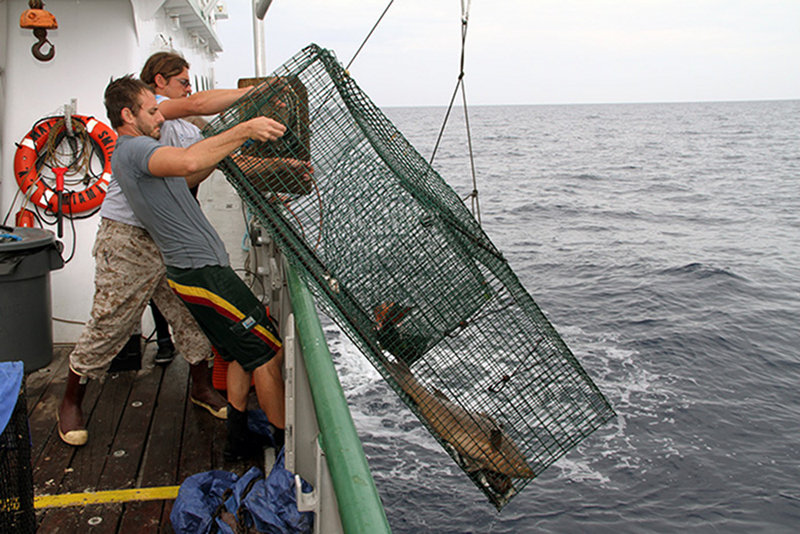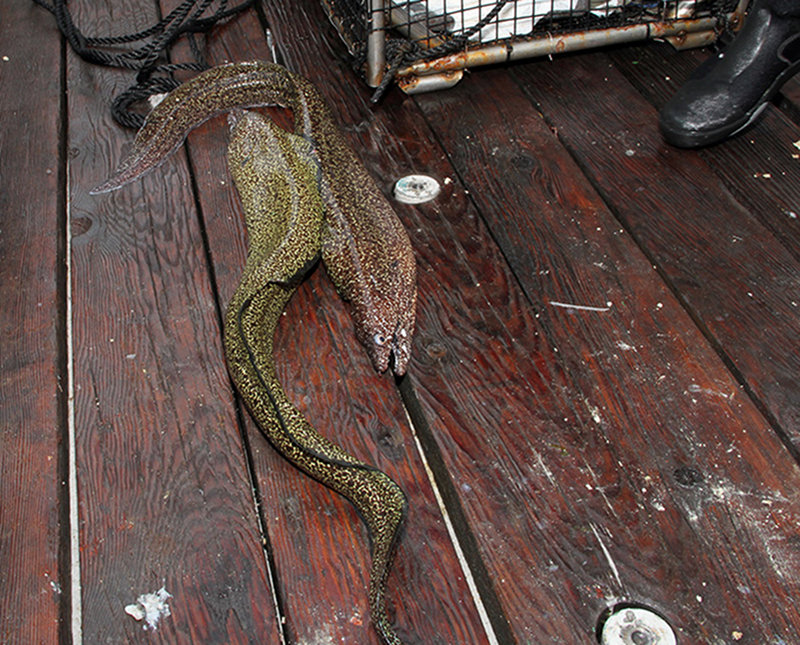
By Felicia Coleman - University of Miami
Chris Malinowski - Florida State University Coastal and Marine Laboratory
August 16, 2013
A red grouper samples the GoPro camera mounted just outsidea chevron trap before entering the trap for the tastier fish bait. A scamp grouper eyes the con’trap’tion cautiously before going inside. Video credit: Chris Malinowski, Florida State University Coastal and Marine Laboratory. Download (mp4, 6.7 MB).
We arrived at Pulley Ridge on August 14 around 1600, having eaten and slept our way across 350 miles of water. The wind picked up a bit that first night. We had a magnificent storm last night. Today, fair winds.

Chris Malinowski gets a hand from ROV technician Jason White, recovering a large chevron fish trap to the deck of the Walton Smith. There are two red grouper and a scamp secured inside. Image courtesy of Brian Cousin, Florida Atlantic University Harbor Branch. Download larger version (jpg, 957 KB).
We’ve completed two days of fish trapping, each day setting five large chevron traps (some mounted with GoPro cameras), each with a companion small chevron trap. When we arrived on site (August 14), we deployed traps by about 1800 hours, starting retrieval the next morning (August 15) at around 0830 and ending at 1230. The routine involves hauling traps from 65 m to 30 m so that “The Divers Chris” (Chris Malinowski and Chris Koenig) can descend and vent fish in the cages with a modified pole spear, thereby limiting the fishes’ exposure to barometric trauma and increasing their survivorship so that they can be tagged and released for capture another day (by trap, hook-and-line, or video). The GoPros captured red grouper (Epinephelus morio) and scamp (Mycteroperca phenax) investigating the trap, some making the decision to enter while others nipped at both bait and camera from the outside. Other fish in video-view included small reef fish and moray eels, while a curious silky shark (Carcharhinus falciformis) followed the Divers Chris. Today we shortened the trap time (but not trap number), quit collecting reproductive samples since most of the oviducts were blocked (this is not the spawning season anyway), and stopped venting fish after 1.5 hours to allow more time for ROV surveying operations.

This beautiful red grouper was fitted with a tag before being returned to the depths. It identifies the fish as being tagged by Florida State University Coastal and Marine Laboratory and has a telephone number to call if seen again. All information provides clues into the life history and home range of individual fish. Image courtesy of Brian Cousin, Florida Atlantic University Harbor Branch. Download larger version (jpg, 705 KB).
Our primary targets are economically important species, which is a good thing because that’s what we caught: red grouper, scamp, and greater amberjack (Seriola dumerili) on Day 1, adding almaco jack (S. rivoliana) on Day 2. We also simultaneously caught moray eels (Gymnothorax sp.), which is not too surprising, given the known associations between grouper and moray eels. In the Red Sea, for instance, groupers and moray hunt cooperatively. A few years ago in Steamboat Lumps Marine Reserve (in the northeast Gulf of Mexico)—again, with the University of North Carolina Wilmington remotely operated vehicle crew – we were mesmerized by very dramatic interactions between red grouper and morays. Hope we can top that here.

These two morays (Gymnothorax sp.) came up in a chevron trap with a pair of groupers, and were returned to the water after a picture or two. Moray eels and groupers have been shown to hunt cooperatively Image courtesy of Brian Cousin, Florida Atlantic University Harbor Branch. Download larger version (jpg, 1.3 MB).
Our sampling goal is to obtain life history data from live fish before tag and release, including age and growth (based on standard length and fin-ray analysis, a technique we have effectively calibrated against otoliths for several species); genetic material (from fin-ray clips); and reproductive state (from gonad biopsies). If a trapped fish dies, we also collect otoliths (to support aging studies), white muscle for mercury analysis, and gonad samples. For the uninitiated, an otolith is a fish’s earbone.
That’s enough for today. Over and out from Pulley Ridge.